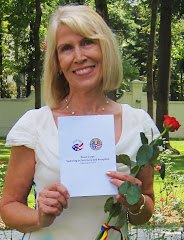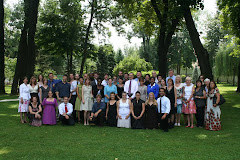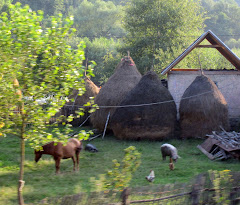Wednesday, August 25, 2010
Sighisoara
We've been in Sighisoara five days and spending an extra night tonight to allow Lee to get over a stomach "bug" that attacked him yesterday--who knows from what, but one of those travel woes one encounters. He's on the mend, and all in all, it's not a bad place to recuperate. The weather is cool and sunny, the natives are friendly and our room is really a suite of sorts, located in a 400-yr.-old building on the main square of the old citadel town on the hill. We're in the attic! But we love it--all the beams of solid ancient wood and the rows of little dormer windows jutting out from the roof. We were sure one of us would bonk our noggin on a beam getting up in the night, but so far, so good. Our pretty tiled bathroom, though, is totally modern with a huge tub and non-splash shower (very special in Romania). We're surrounded by bell towers of various churches and have no problem remembering the time! The chimes are all in different tones, and if I were to stay a few more days, I could probably identify which were the Orthodox, the Roman Catholic, and the Lutheran. ***Sighisoara (in the Carpathian Mountains in the Transylvania sector of Romania)was settled by the Saxons in the 14th century and inhabited by mostly Germans for centuries until many moved back to Germany after WWII. The Hungarians have been here since the early days, too, when the King of Hungary granted settlers special privileges if they moved here and learned the excellent crafts of the village. One of the few fortified towns in the world still inhabited, it's picture-book perfect in its Medieval cobble-stone, meandering little streets and stone buildings. A great fire in the 1600's burned away much of the village, but it built back and the original buildings don't appear that different from all the rest. The eight towers for defense around the wall were built and maintained by different guilds. They are all very distinct and reflect the wealth of the particular guild. But I like the Cobblers' quaint one the best and it's the only one that is currently a residence; the caretaker of the Catholic Church yard and cemetery lives here and is a fine flower gardener! And of course, the Dracula house is here, too, as Vlad and his father lived here for a period of time. The house now houses an inn, art gallery, and little outdoor cafe which specializes in Dracula ice cream concoctions. As is true in nearly every Romanian town, a statue of Vlad Tepes, national hero, stands in a prominent place.***Below the fortified hill (with its grand clock tower, churches, and city hall) is the rest of Sighisoara, also quite beautiful on the banks of the Tarnava Mare River, but holding inferior status for much of the history of the city, when the master craftsmen and religious leaders on the hill held all the power. When the Turks or other tribes attacked, however, all were brought into the fold and helped in the defense. Interestingly, the bloc apartment buildings constructed during the recent communist era seem to have been remodeled, especially the roof lines, and made more in keeping with the architecture around them.***OK, so much for your travelogue/history lesson for the day. Must go buy water and provisions for our 7-hour train trip that begins at 8:30am tomorrow. I'll post pictures when I'm back to my site and will tell you about the brunch we plan to "put on" this Sunday. La revedere.
Subscribe to:
Post Comments (Atom)







Sounds wonderful. I would love to see a walled city still being lived in. Your description is almost as good.
ReplyDeleteFrom your description, I can just imagine how wild I would be taking pictures. Hope Lee's bug goes away and stays away.
ReplyDeleteI'm experiencing everything with you. I'm ready to grab my passport and head your way.
ReplyDeleteGreat descriptions! Ancient low beamed ceilings, rows of dormer windows, YUM! Dracula ice cream goodies!
ReplyDelete